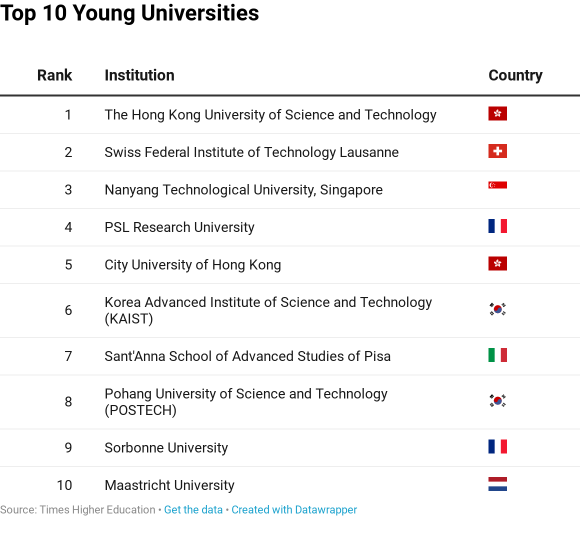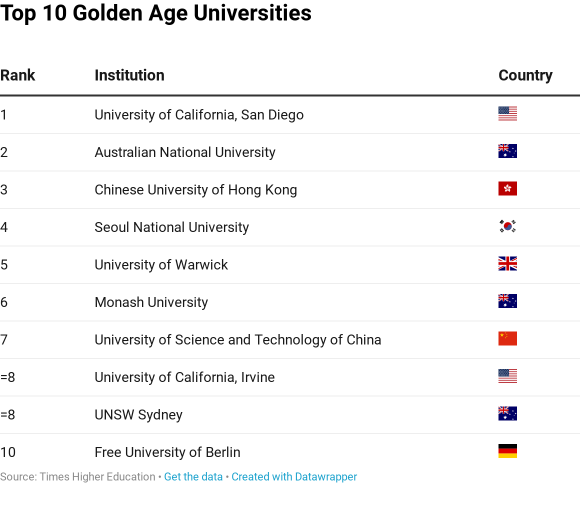
Credit: Hong Kong University of Science and Technology
“We can do anything we want”: How young universities say they're stealing a march on older competitors
The latest Times Higher Education rankings highlight innovation among universities established since 1945 and others aged 50 and under.
27 June 2019

Hong Kong University of Science and Technology
A South Asian science university founded less than 30 years ago has retained the top spot in a global ranking of 351 “young” higher education institutions, one of five from the region to make the top 10 in 2019.
In the latest Times Higher Education (THE) Young Universities ranking, the Hong Kong University of Science and Technology, founded in 1991, comes top for the second year running. It again beat the 50-year-old Swiss Federal Institute of Technology, Lausanne (École Polytechnique Fédérale de Lausanne), Switzerland, a specialist in natural sciences and engineering that ranked number two.
THE first published its ranking of institutions under 50 years old in 2012. It uses the same 13 indicators as its world university rankings, focusing specifically on teaching, research, citations, international outlook and industry income. But the young university ranking gives less weight to subjective indicators of academic reputation, which older institutions have had more time - often many centuries - to cultivate.
In third place once more is Singapore’s Nanyang Technological University. The City University of Hong Kong is ranked fifth (it came seventh in 2018), followed by the Korea Advanced Institute of Science and Technology, in sixth place for the second year running. A second Korean institution, Pohang University of Science and Technology, is ranked eighth again.

Other institutions in the top 10 all hail from Europe. Paris Science et Lettres Research University (PSL) comes fourth again, Scuola Superiore Sant’ Anna in Pisa, Italy, is in seventh place (in 2018 it came ninth).
The Sorbonne University, established last year when Paris-Sorbonne University (founded in 1257) merged with Pierre et Marie Curie University and smaller institutions, ranks ninth in 2019.
When tradition is a hindrance
Pam Benoit, provost at the University of Alabama at Birmingham (UAB), US, established in 1969 and ranked 12th, described qualities that distinguish younger institutions from their older counterparts, for whom a respect for convention and tradition was a “hindrance.”
“I can recall older universities saying ‘we’ve always done it that way,’ whereas our first president said ‘We don’t have any traditions to uphold. We can do anything we want,’” she told the THE’s Young Universities Summit, hosted at the University of Surrey in Guildford, UK.
Newer universities are more responsive to the evolving needs of younger students, argued Benoit at the meeting, citing the Maastricht University, Netherlands, (which dropped five places in 2019, coming tenth). The university, founded in 1976, pioneered problem -based learning and enjoys a 93% graduate employment rate, she said.
Compared to older institutions, new institutions are also more effective at championing diversity, conducting interdisciplinary research to solve “real-world problems”, cultivating an entrepreneurial spirit, and are more engaged in local communities, Benoit added.
Forty-one percent of UAB students are from under-represented minority groups, 64% are female, and 29% are first generation students, she told the meeting.
She said UAB’s medical school is one of eight whose NIH funding has increased by US$100 million over the last five years, and it is the only new university to achieve this.
“The combined age of the others is 1120 years,” she said. “A strong interdisciplinary culture and shared lab resources is coded into our DNA. When the NIH started looking for interdisciplinary research, UAB was already doing it. We didn’t have the funding to do it any other way.”
Jess Wade, a physicist at Imperial College London, defended the innovation and interdisciplinary record of older institutions. “Academic research is always interdisciplinary now, and that feeds into how we train undergraduates,” she told a panel discussion on world-class institutions of the future. “I don’t think it’s only happening in young universities.”
Reputation counts
Wade explained that from 2019 all undergraduate courses at Imperial will include a module known as iExplore, straddling business skills, humanities and social sciences, STEMM subjects (science, technology, engineering, mathematics and medicine) and multidisciplinary projects.
A university’s reputation is skewed by academic publishing and peer review, she said, which are biased in favour of western older established universities.
Wade argued that reputation, rather than purely career development, remains important for science students in particular, many of whom will be looking to do postgraduate research. “When you do a science degree you are thinking about an academic career, not about career development,” she said.
The Young University rankings was one of two unveiled at the summit. The “Golden Age” ranking focuses on 272 institutions founded between 1945 and 1968.

Three of the top 10 Golden Age Universities also hail from Asia – the Chinese University of Hong Kong (founded in 1963) ranks third again, Seoul National University (founded in 1946) comes fourth once more, and the University of Science and Technology of China ranks seventh. It was established in 1958 and came 13th in 2018.
In first place again is the University of California, San Diego (founded 1960), followed by the Australian National University in Canberra (founded 1946). Monash University, founded in 1948 and based in Melbourne, ranks sixth, and the UNSW Sydney is in joint eighth place with the University of California, Irvine. The institutions date back to 1949 and 1965 respectively.
Two European universities make the top 10. The University of Warwick, UK, ranks fifth (it was founded in 1965), and the Free University of Berlin, comes 10th. It dates back to 1948.
The full ranking can be found here.
The underlying methodology behind the ranking can be found here.
Related stories:
